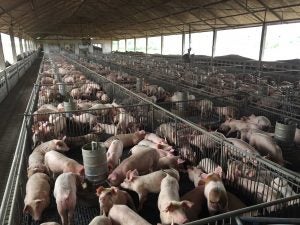For the first time since 2016, the USDA’s National Agricultural Statistics Service did not publish the July Cattle Inventory report due to budget constraints. This report is crucial for producers and analysts to gauge cattle inventory trends and plan accordingly.
Its absence makes it challenging to understand current inventory levels and future market conditions, creating a significant information gap in the industry. However, the American Farm Bureau Federation economists have prepared a market update for the second half of 2024 that includes cattle, hogs, and poultry.
Cattle inventories
The January report estimated the total U.S. cattle and calves population at 87.2 million. The 2024 cattle inventory is the lowest since 1951, leading to high beef prices as supply tightens.
Prolonged drought and high costs have led to increased cow and heifer marketing since 2020, significantly reducing the number available for calf production. This reduction in breeding stock has long-term implications for herd size and beef supply. The current market conditions reflect these challenges, as producers struggle to maintain herd numbers while dealing with environmental and economic pressures.
The July Cattle on Feed report indicated 11.3 million cattle and calves on feed, up 1 percent from last year. However, a high proportion of these are heifers, suggesting that farmers are not currently focused on rebuilding their herds. Instead, they are opting to market more heifers, further depleting the future breeding stock. This decision is likely driven by immediate financial pressures and the uncertainty surrounding feed availability and costs.
Estimating the calf crop size is challenging without the July report. Historically low calf crop numbers are likely, impacting future herd expansion. This uncertainty makes it difficult for stakeholders to predict market trends and make informed decisions about production and investment. The lack of reliable data hinders the ability to forecast supply and demand dynamics accurately, increasing market volatility.
High summer demand has pushed choice grade beef prices above $300/cwt, reflecting strong consumer demand. The current spread between choice and select grade beef is $13.11, highlighting the premium placed on higher-quality beef. Despite these high prices, the market faces challenges due to the constrained supply and ongoing uncertainty about inventory levels.

Hogs supply
The USDA’s Quarterly Hogs and Pigs report, released on June 27, indicated a U.S. hog inventory of 74.5 million head, up 1 percent from June 2023. The breeding inventory was down 3 percent, while market hogs were up 2 percent. The March-May pig crop was 34 million, up 2 percent from last year, with an average of 11.56 pigs saved per litter. USDA estimates 2024 pork production at 28 billion pounds, about 3 percent more than 2023. Increased production could lower hog prices in the second half of 2024.
Hog farmers faced average losses of $31 per head in 2023 due to high input costs. Iowa State University’s June 2024 estimate shows a profit of $8.82 per hog, driven by a 25 percent drop in feed costs. Despite lower feed costs, elevated fixed costs from inflation remain a challenge.
The USDA’s July World Agricultural Supply and Demand Estimates report projects annual U.S. per capita pork demand at 51 pounds per person, up 0.4 pounds from June projections and 0.8 pounds from last year. Domestic demand remains insufficient to raise prices significantly, but export demand has been strong, with total pork export sales up 6.7 percent from 2023.
Mexico has been a key trade partner, significantly outpacing other importers. High weekly slaughter numbers mean more product is available, but higher prices for products like hams may slow export demand from Mexico, putting downward pressure on prices.
The CME lean hog index has been rising since early July, reaching $91.85/cwt on July 29. The national average cash price increased to $84.07/cwt. Elevated slaughter numbers are expected to continue into fall and winter, potentially lowering cash prices.
The USDA adjusted 2024 broiler production and prices down in its July Livestock, Dairy, and Poultry Outlook. May 2024 broiler production is estimated at 3.99 billion pounds, down over 1 percent from last year. Average weights are also down. The 2024 forecast for broiler production is 46.78 billion pounds, up about 0.8 percent from 2023. Chicken remains the most demanded meat in the U.S., with per capita demand for broiler meat at 101.6 pounds per person, up 2.1 pounds from 2023, likely due to higher beef prices.

Egg supply
The USDA’s June Chickens and Eggs report estimates June egg production at 8.81 billion eggs, down 2 percent from last year. The breakdown includes 7.56 billion table eggs and 1.25 billion hatching eggs. The number of layers in June 2024 was 371 million, down 3 percent, while egg production per 100 layers was up 1 percent.
Egg sets (eggs placed in incubators) peaked in April at 5.4 percent above the five-year average. In May, chicks placed were 4 percent above the five-year average. Egg sets in July were also 4 percent above the year-over-year average, while chick placements were up 0.7 percent. Table egg layers have faced HPAI outbreaks, with the most recent detections affecting about 3.4 million birds in Colorado. Despite these losses, the June egg-laying flock inventory was 305.9 million birds, showing resilience. USDA adjusted second quarter production up 10 million dozen to 1.9 billion dozen eggs, and 2024 table egg production is projected at just shy of 7.8 billion dozen eggs, about 0.9 percent below 2023.
The average New York June wholesale price for large eggs was $2.58 per dozen. The average second-quarter price was $2.27 per dozen, about 3 percent above last month’s estimate and 70 percent above the average second-quarter price for 2023. Egg prices are stable for now, but potential fall outbreaks of HPAI could drive prices up.


